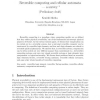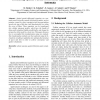139 search results - page 2 / 28 » How Common Can Be Universality for Cellular Automata |
DNA
2005
Springer
13 years 11 months ago
2005
Springer
Recent experimental progress in DNA lattice construction, DNA robotics, and DNA computing provides the basis for designing DNA cellular computing devices, i.e. autonomous nano-mech...
TCS
2008
13 years 5 months ago
2008
Reversible computing is a paradigm where computing models are so defined that they reflect physical reversibility, one of the fundamental microscopic physical property of Nature. ...
STACS
2009
Springer
14 years 16 days ago
2009
Springer
Cellular automata (CA) are dynamical systems defined by a finite local rule but they are studied for their global dynamics. They can exhibit a wide range of complex behaviours an...
EUROGP
2003
Springer
13 years 11 months ago
2003
Springer
This paper presents a method of using genetic programming to seek new cellular automata that perform computational tasks. Two genetic algorithms are used : the first one discovers ...
BIOCOMP
2009
13 years 3 months ago
2009
Abstract-- Spatial partial differential equations are commonly used to describe systems of biological entities, such as patterns created by desert vegetation and biovermiculation g...


